Submitted:
20 September 2024
Posted:
23 September 2024
You are already at the latest version
Abstract
Keywords:
1. Introduction
2. Methods and Data
2.1. Ionosonde Measurements – Amplitude Method
2.2. Riometer Measurements
| Station | Abbreviation | Latitude | Longitude | Frequency |
| Abisko | ABI | 68.40°N | 18.90°E | 30.0 MHz |
| Ivalo | IVA | 68.55°N | 27.28°E | 30.0 MHz |
| Sodankylä | SOD | 67.42°N | 26.39°E | 30.0 MHz |
| Rovaniemi | ROV | 66.78°N | 25.94°E | 32.4 MHz |
| Oulu | OUL | 65.08°N | 25.90°E | 30.0 MHz |
| Jyväskylä | JYV | 62.42°N | 25.28°E | 32.4 MHz |
2.3. D-RAP Model
3. Results
3.1. Comparing the Results of Amplitude Method with D-RAP
| Measured values at 2.5 MHz | ||||||
| Date | Class | Time (UT) of peak or of first record after Fadeout | X-ray flux at that time | JR | PQ | VT |
| 2017-9-4 | C8.3 | 12:22 | 8.5162E-07 | 17.120 | 23.828 | 21.122 |
| 2017-9-4 | M1.5 | 15:30 | 3.1434E-06 | 8.127 | 20.256 | 12.7977 |
| 2017-9-5 | M3.2 | 4:53 | - | 3.99734 | 6.773 | 8.239 |
| 2017-9-5 | M3.8 | 6:40 | 9.8452E-06 | 13.6911 | 18.288 | 16.611 |
| 2017-9-6 | X2.2 | 15:15 | 1.9817E-06 | 15.41 | 20.3 | 19.4613 |
| 2017-9-6 | X9.3 | 15:15 | 1.9817E-06 | 15.41 | 20.3 | 19.4613 |
| 2017-9-7 | M1.4 | 10:30 | 9.9090E-08 | 20.44 | 22.124 | 22.4674 |
| 2017-9-7 | M7.3 | 10:30 | 9.9090E-08 | 20.44 | 22.124 | 22.4674 |
| 2017-9-7 | X1.3 | 15:15 | 3.3895E-06 | 15.96 | 23.6961 | 15.4766 |
| 2017-9-8 | M8.1 | 8:45 | 1.6497E-07 | 15.67 | 19.46 | 22.0385 |
| 2017-9-8 | M2.9 | 15:47 | 7.1936E-06 | 17.4162 | 23.627 | 18.15 |
| 2017-9-9 | M3.7 | 12:15 | 2.9838E-07 | 15.06 | 24.01 | 21.6762 |
| 2017-9-10 | X8.2 | 16:45 | 5.1431E-05 | 19.04 | 22.3796 | 12.7332 |
| D-RAP determined values at 2.5 MHz | ||||||
| Date | Class | Time (UT) of peak or of first record after Fadeout | X-ray flux at that time | JR | PQ | VT |
| 2017-9-4 | C8.3 | 12:22 | 8.5162E-07 | 15,14 | 17,58 | 19,16 |
| 2017-9-4 | M1.5 | 15:30 | 3.1434E-06 | 7,88 | 8,85 | 7,88 |
| 2017-9-5 | M3.2 | 4:53 | - | 2,10 | 1,66 | 3,00 |
| 2017-9-5 | M3.8 | 6:40 | 9.8452E-06 | 11,99 | 13,54 | 16,80 |
| 2017-9-6 | X2.2 | 15:15 | 1.9817E-06 | 12,83 | 13,54 | 12,83 |
| 2017-9-6 | X9.3 | 15:15 | 1.9817E-06 | 12,83 | 13,54 | 12,83 |
| 2017-9-7 | M1.4 | 10:30 | 9.9090E-08 | 6,27 | 7,17 | 8,00 |
| 2017-9-7 | M7.3 | 10:30 | 9.9090E-08 | 6,27 | 7,17 | 8,00 |
| 2017-9-7 | X1.3 | 15:15 | 3.3895E-06 | 12,83 | 14,40 | 13,54 |
| 2017-9-8 | M8.1 | 8:45 | 1.6497E-07 | - | - | - |
| 2017-9-8 | M2.9 | 15:47 | 7.1936E-06 | 9,61 | 10,39 | 9,61 |
| 2017-9-9 | M3.7 | 12:15 | 2.9838E-07 | 14,40 | 16,80 | 18,36 |
| 2017-9-10 | X8.2 | 16:45 | 5.1431E-05 | 6,60 | 6,83 | 3,35 |
3.2. Comparing the Riometer Data with D-RAP
4. Discussion and Concluding Remarks
- The X-class flares caused 1–2.6 dB attenuation at 30–32.5 MHz based on riometer data (Figure 6 and Figure 7.), while the absorption changes were between 10 and 15 dB in the 2.5–4.5 MHz frequency range (thus 10 times higher) according to the amplitude data measured by the Digisondes (Figure 4 and Figure 5.).
- The ionospheric response to X-ray flux changes (flares) at midlatitude measured by the ionosondes show a solar zenith angle dependence (Figure 4 and Figure 5.), this dependence is not evident for the case of the riometers measurement ( Figure 6 and Figure 7.). It is true also for the results of the D-RAP model regarding the same flares and same coordinates (Figure 4, Figure 5, Figure 6 and Figure 7.).
- The impact caused by the energetic particles after the solar flares are clearly seen in the riometer data (Figure 6 and Figure 7.), while it can be observed only at Juliusruh (~55°) in some certain cases (Figure 5.) among the Digisonde stations. Consequently, the absorption changes as a result of the particle precipitation is significant at high latitudes, but decreases rapidly with decreasing latitude, and is no longer detectable below the sub-auroral region.
- The main conclusion from the comparison of the riometer data with the D-RAP model is that the model underestimates the values obtained from the riometers during the X-class solar flares (X-ray flux changes) while it overestimates the caused impact during the particle events (Figure 6 and Figure 7.).
- According to the current results the amplitude method seems to be applicable to detect the ionospheric absorption changes during flare events taking into consideration its limitations.
Supplementary Materials
Author Contributions
Funding
Data Availability Statement
Acknowledgments
Conflicts of Interest
References
- Zolesi, B.; Cander, L. Ionospheric Prediction and Forecasting, Springer Geophysics, Springer Heidelberg New York Dordrecht London, 2014. [CrossRef]
- Tsurutani, B.T.; Verkhoglyadova, O.P.; Mannucci, A.J.; Lakhina, G.S.; Li, G.; Zank, G.P.; et al. A brief review of “solar flare effects” on the ionosphere. Radio Sci. 2009, 44, 1–14. [Google Scholar] [CrossRef]
- Rishbeth, H.; Garriot, O.K. Introduction to Ionospheric Physics. Int. Geophys. Ser. 1969, Vol. 14, Academic Press, NY.
- Davies, K.; Ionospheric radio (No. 31). IET.; 1990.
- Barta, V.; Sátori, G.; Berényi, K.A.; Kis, Á.; and Williams, E. Effects of solar flares on the ionosphere as shown by the dynamics of ionograms recorded in Europe and South Africa. Annales Geophysicae 2019, 37, 747–761. [Google Scholar] [CrossRef]
- Tao, C.; Nishioka, M.; Saito, S.; Shiota, D.; Watanabe, K.; Nishizuka, N.; et al. Statistical analysis of short-wave fadeout for extreme space weather event estimation. Earth, Planets Space 2020, 72, 173. [Google Scholar] [CrossRef]
- Barta, V.; Natras, R.; Srećković, V.; Koronczay, D.; Schmidt, M.; Šulic, D. Multi-instrumental investigation of the solar flares impact on the ionosphere on 05-06 December 2006. Front. Environ. Sci. 2022, 10, 904335. [Google Scholar] [CrossRef]
- Fiori, R.A.D.; Trichtchenko, L.; Balch, C.; Spanswick, E.; Groleau, S. Characterizing auroral-zone absorption based on global Kp and regional geomagnetic hourly range indices. Space Weather 2020, 18, e2020SW002572. [Google Scholar] [CrossRef]
- Little, C.G. High latitude ionospheric observations using extra-terrestrial radio waves. Proc. IRE 1954, 42, 1700. [Google Scholar] [CrossRef]
- Stauning, P. Investigations of ionospheric radio wave absorption processes using imaging riometer techniques. J. Atmos. solar-terrestrial Phys. 1996, 58, 753–764. [Google Scholar] [CrossRef]
- Ogunmodimu, O.; Honary, F.; Rogers, N.; Falayi, E.O.; Bolaji, O.S. Solar flare induced cosmic noise absorption. NRIAG Journal of Astronomy and Geophysics 2018, 7, 31–39. [Google Scholar] [CrossRef]
- Honary, B.; Hargreaves, J.; Browne, S. An imaging riometer for ionospheric studies. Electronics & Communication Engineering Journal 1995, 7, 209–217. [Google Scholar] [CrossRef]
- Kero, A.; Enell, C.-f.; Ulich, T.; Turunen, E.; Rietveld, M.T.; Honary, F.H. Statistical signature of active. D-region HF heating in IRIS riometer data from 1994-2004. Annales Geophysicae 2007, 25, 407–415. [Google Scholar] [CrossRef]
- Sripathi, S.; Balachandran, N.; Veenadhari, B.; Singh, R.; and Emperumal, K. Response of the equatorial and low-latitude ionosphere to an intense X-class solar flare (X7/2B) as observed on 09 August 2011. J. Geophys. Res. Space Phys. 2013, 118, 2648–2659. [Google Scholar] [CrossRef]
- Nogueira, P.A.B.; Souza, J.R.; Abdu, M.A.; Paes, R.R.; Sousasantos, J.; Marques, M.S.; ... & Cueva, R.Y.C. Modeling the equatorial and low-latitude ionospheric response to an intense X-class solar flare. Journal of Geophysical Research: Space Physics 2015, 120, 3021–3032. [CrossRef]
- Curto, J.J.; Marsal, S.; Blanch, E.; and Altadill, D. Analysis of the solar flare effects of 6 September 2017 in the ionosphere and in the Earth’s magnetic field using Spherical Elementary Current Systems. Space weather. J. 2018, 16, 1709–1720. [Google Scholar] [CrossRef]
- de Paula, V.; Segarra, A.; Altadill, D.; Curto, J.J.; Blanch, E. Detection of Solar Flares from the Analysis of Signal-to-Noise Ratio Recorded by Digisonde at Mid-Latitudes. Remote Sensing 2022, 14, 1898. [Google Scholar] [CrossRef]
- Buzás, A.; Kouba, D.; Mielich, J.; Burešová, D.; Mošna, Z.; Koucká Knížová, P.; and Barta, V. Investigating the effect of large solar flares on the ionosphere based on novel Digisonde data comparing three different methods. Frontiers in Astronomy and Space Sciences 2023, 10. [Google Scholar] [CrossRef]
- Fiori, R.A.D.; Chakraborty, S.; Nikitina, L. Data-based optimization of a simple shortwave fadeout absorption model. Journal of Atmospheric and Solar-Terrestrial Physics 2022, 230, 105843. [Google Scholar] [CrossRef]
- Fiori, R.A.D.; Rogers, N.C.; Nikitina, L.; Lobzin, V.; Rock, E. Duration and extent of solar X-ray flares and shortwave fadeouts likely to impact high frequency radio wave propagation based on an evaluation of absorption at 30 MHz. Journal of Atmospheric and Solar-Terrestrial Physics 2023, 252, 106148. [Google Scholar] [CrossRef]
- Eccles, J.V.; Hunsucker, R.D.; Rice, D.; Sojka, J.J. Space weather effects on midlatitude HF propagation paths: Observations and a data-driven D-region model. Space Weather 2005, 3. [Google Scholar] [CrossRef]
- Levine, E.V.; Sultan, P.J.; Teig, L.J. A parameterized model of X-ray solar flare effects on the lower ionosphere and HF propagation. Radio Sci. 2019, 54, 168–180. [Google Scholar] [CrossRef]
- Chakraborty, S.; Baker, J.B.H.; Fiori, R.A.D.; Ruohoniemi, J.M.; Zawdie, K.A. A model framework to estimate ionospheric HF absorption produced by solar flares. Radio Sci. 2021, 56. [Google Scholar] [CrossRef]
- Sales, G.S. HF absorption measurements using routine digisonde data, Conference material, XII. Lowell, MA: International Digisonde Forum, University of Massachusetts. 2011.
- Friis, H.T. A note on a simple transmission formula. Proc. IRE 1946, 34, 254–256. [Google Scholar] [CrossRef]
- Website: https://www.sgo.fi/.
- Akmaev, R.A.; Newman, A.; Codrescu, M.; Schulz, C.; Nerney, E. D-RAP model validation: I. Scientific report. 2010, [Available at https:// www.ngdc.noaa.gov/stp/drap/DRAP-V-Report1.pdf.].
- Website: https://github.com/hayesla/NOAA-DRAP-Analysis/tree/master.
- Schumer, E.A. Improved Modeling of Midlatitude D-Region Ionospheric Absorption of High Frequency Radio Signals during Solar X-Ray Flares, PhD Dissertation, 2009, AFIT/DS/ENP/09-J01, U.S. Air Force. Wright-Patterson Air Force Base, Ohio.
- Stonehocker, G.H.; Advanced telecommunication forecasting technique in AGY, 5th., Ionospheric forecasting. AGARD (Advis. Group Aerosp. Res. Dev) Conf. Proc. 1970, 29, 27–31.
- Kolarski, A.; Veselinović, N.; Srećković, V.A.; Mijić, Z.; Savić, M.; and Dragić, A. Impacts of extreme space weather events on september 6th, 2017 on ionosphere and primary cosmic rays. Remote Sensing 2023, 15, 1403. [Google Scholar] [CrossRef]
- Fagundes, P.R.; Pezzopane, M.; Habarulema, J.B.; Venkatesh, K.; Dias, M.A.L.; Tardelli, A.; ... Seemala, G.K. Ionospheric disturbances in a large area of the terrestrial globe by two strong solar flares of September 6, 2017, the strongest space weather events in the last decade. Advances in Space Research 2020, 66, 1775–1791. [CrossRef]
- Sinha, S.; Vichare, G.; Sinha, A.K. Hemispheric comparison of solar flare associated cosmic noise absorption (SCNA) from high latitude stations: Maitri (70.75° S, 11.75° E) and Abisko (68.4° N, 18.9° E). Frontiers in Astronomy and Space Sciences 2024, 11, 1347874. [Google Scholar] [CrossRef]
- He, L.; Nishino, M.; Zhang, B.; Liu, R.; Liu, Y.; Liu, S.; ... Yamagishi, H. Absorption events associated with solar flares. Chinese Science Bulletin 2001, 46, 369–372. [CrossRef]
- Romano, V.; Cerrone, M.; Perrone, L.; Pietrella, M. Magnetic and solar effects on ionospheric absorption at high latitude. Annals of Geophysics 2002, 45. [Google Scholar] [CrossRef]
- Fiori, R.A.D.; and Danskin, D.W. Examination of the relationship between riometer-derived absorption and the integral proton flux in the context of modeling polar cap absorption. Space Weather 2016, 14, 1032–1052. [Google Scholar] [CrossRef]
- Heino, E.; Verronen, P.T.; Kero, A.; Kalakoski, N.; Partamies, N. Cosmic noise absorption during solar proton events in WACCM-D and riometer observations. Journal of Geophysical Research: Space Physics 2019, 124, 1361–1376. [Google Scholar] [CrossRef]
- Rogers, N.C.; Honary, F. Assimilation of real-time riometer measurements into models of 30 MHz polar cap absorption, J. Space Weather Space Clim. 2015, 5, A8. [Google Scholar] [CrossRef]
- Sellers, B.; Hanser, F.A.; Stroscio, M.A.; Yates, G.K. The night and day relationships between polar cap riometer absorption and solar protons. Radio Sci. 1977, 12, 779–789. [Google Scholar] [CrossRef]
- National Research Council Severe Space Weather Events—Understanding Societal and Economic Impacts: A Workshop Report, 2008, 144 pp., Natl. Acad. Press, Washington, D.C.

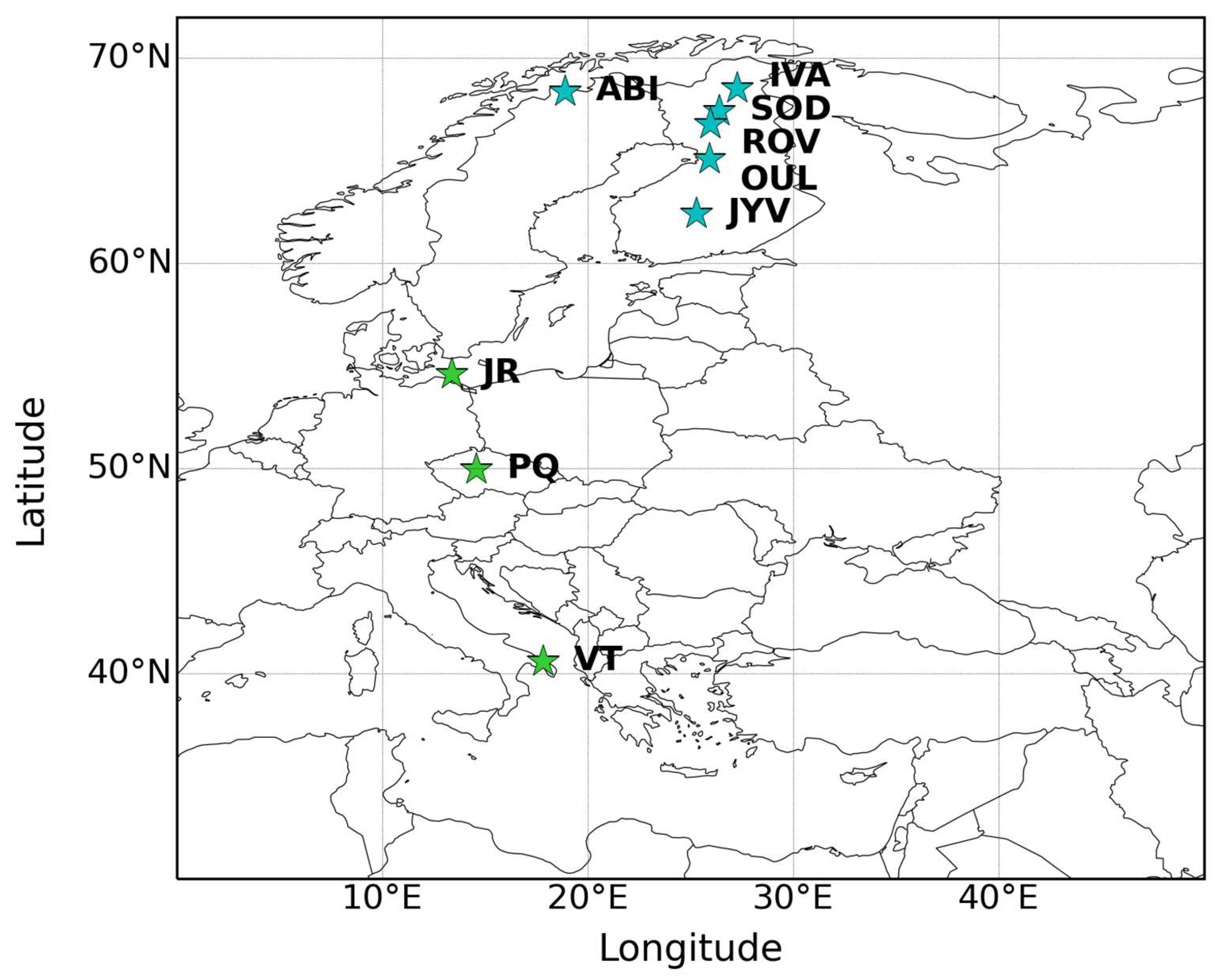
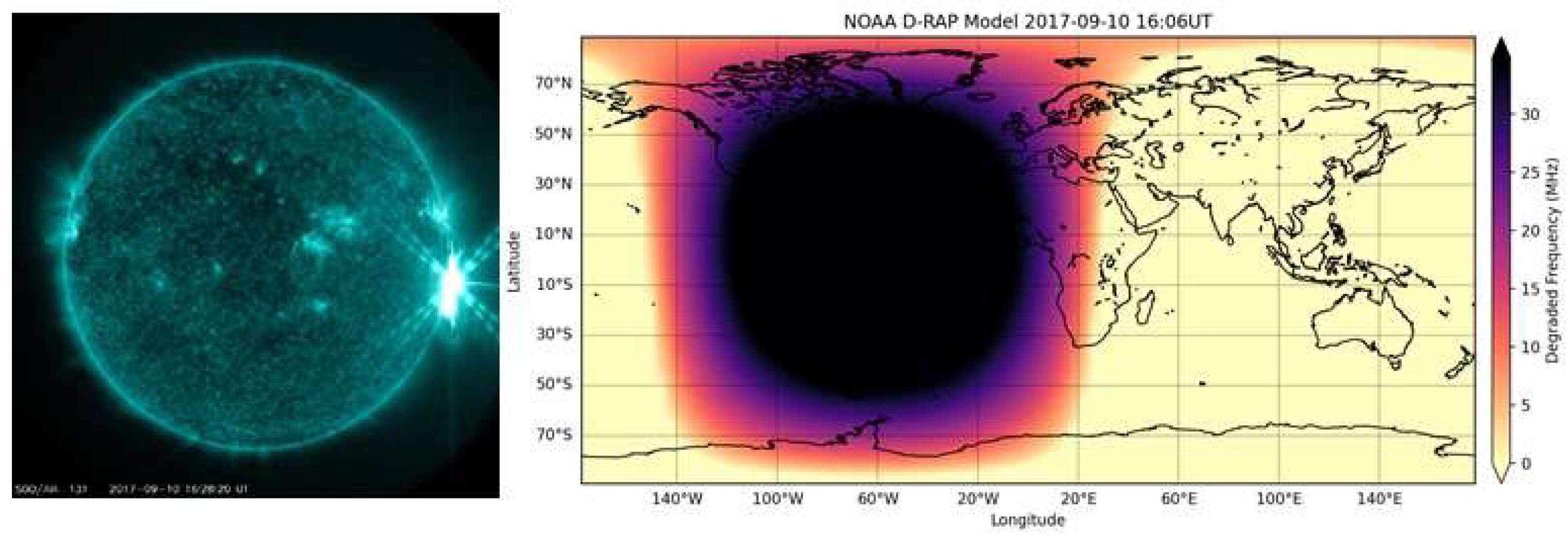
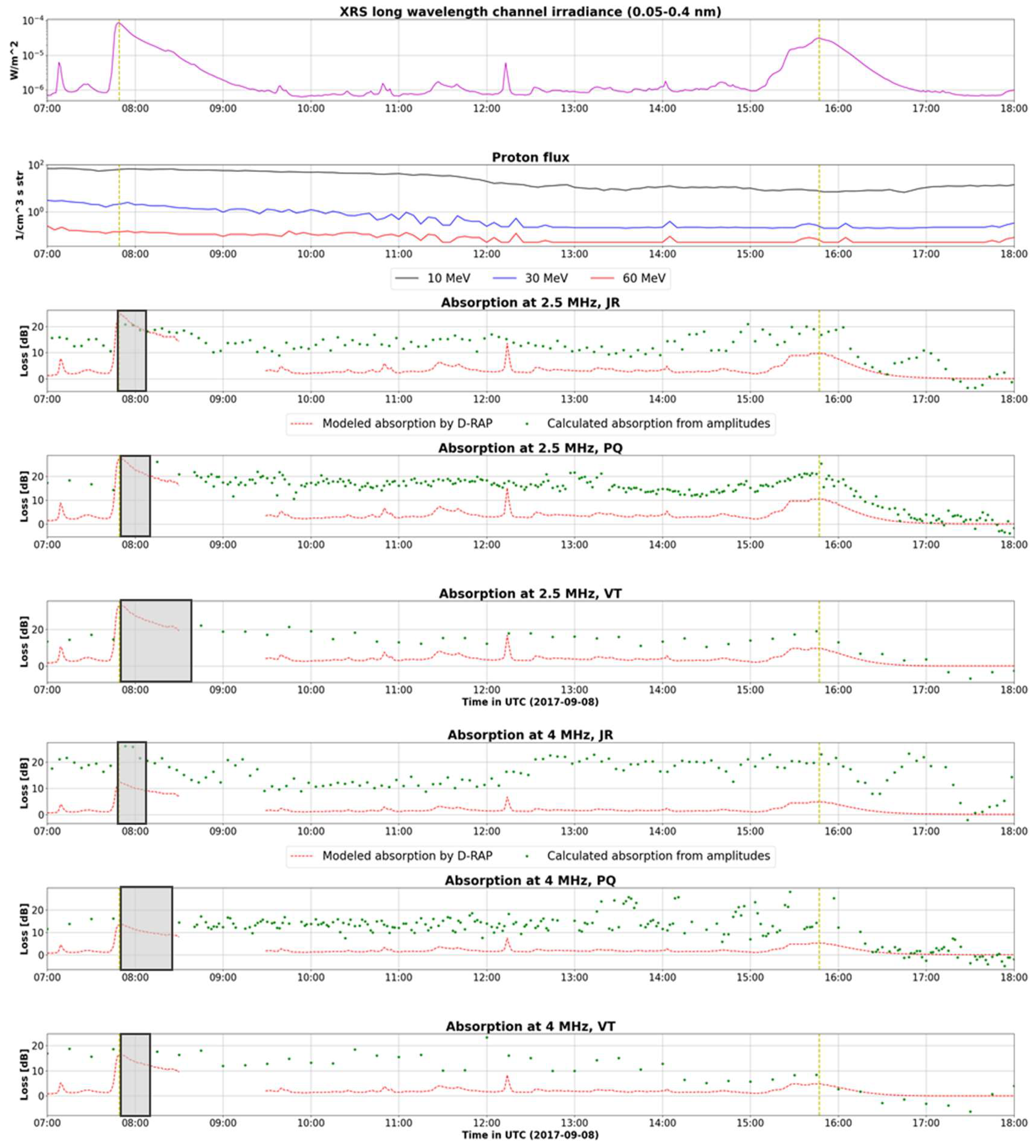
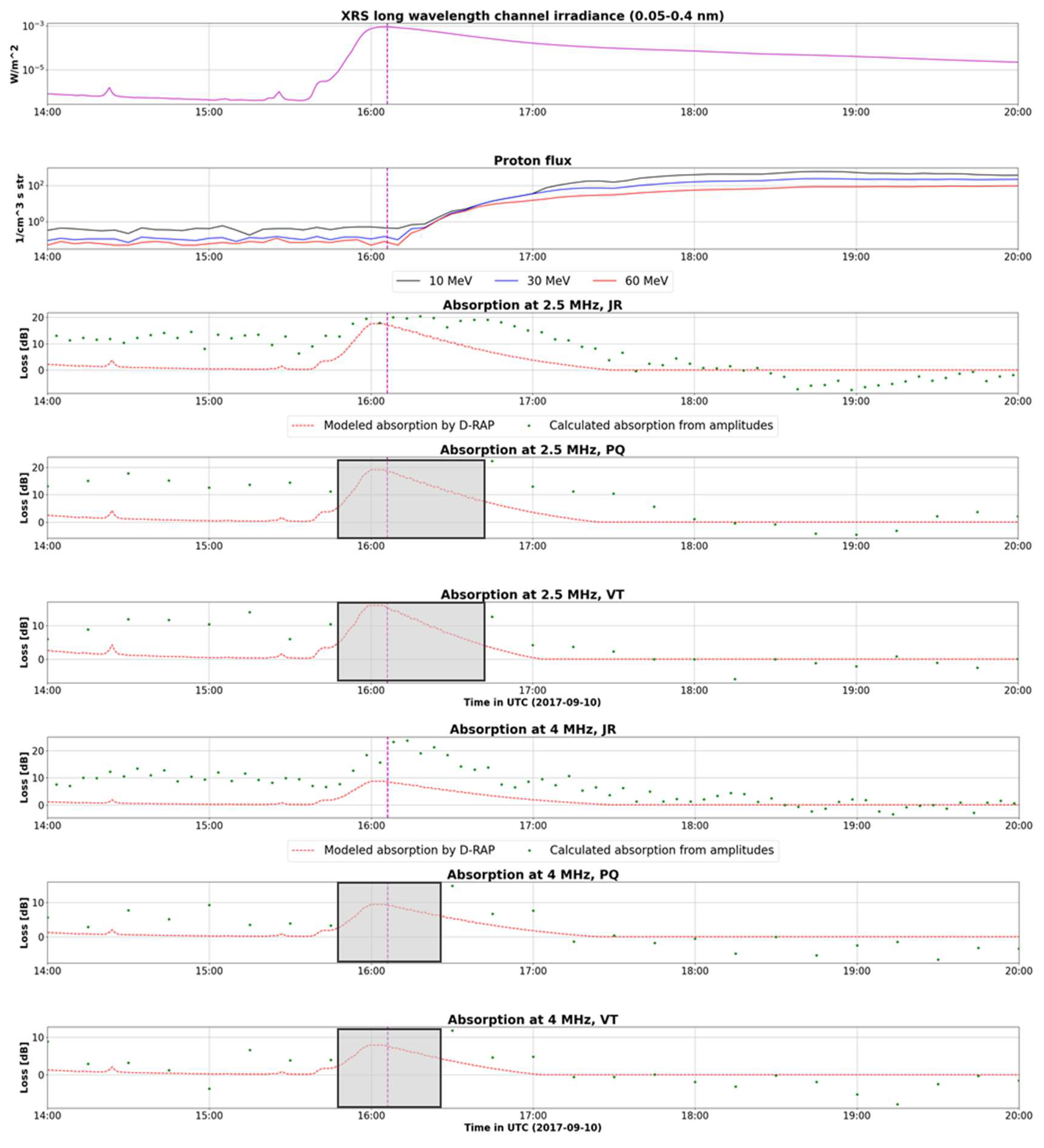
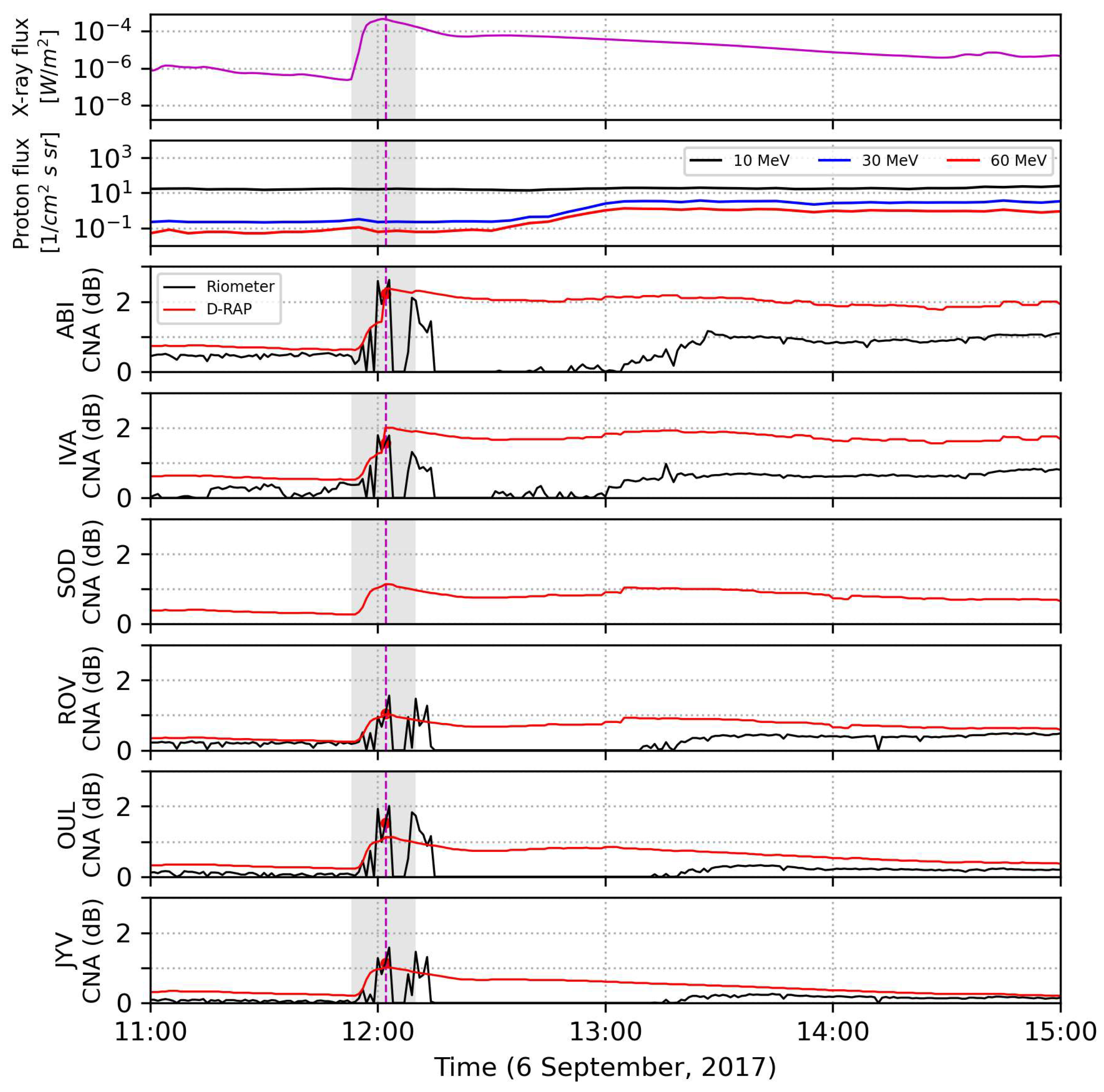
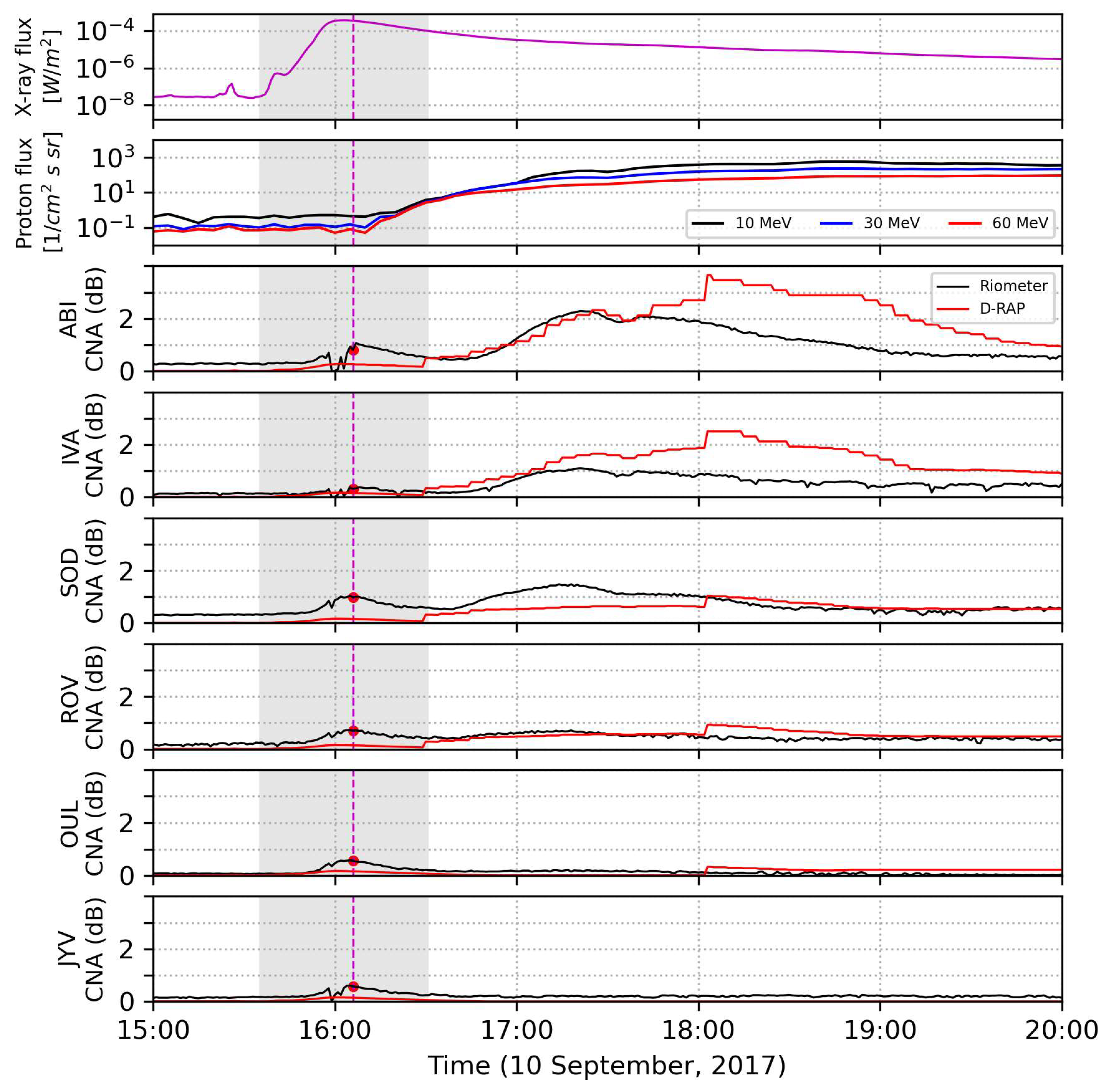
| Date | Start time | Peak time | End time | Duration (min) | Class |
| 04 Sep 2017 | 11:54 | 12:22 | 14:00 | 126 | C8.3 |
| 04 Sep 2017 | 15:11 | 15:30 | 15:33 | 22 | M1.5 |
| 05 Sep 2017 | 4:33 | 4:53 | 5:07 | 34 | M3.2 |
| 05 Sep 2017 | 6:33 | 6:40 | 6:43 | 10 | M3.8 |
| 06 Sep 2017 | 8:57 | 9:10 | 9:17 | 20 | X2.2 |
| 06 Sep 2017 | 11:53 | 12:02 | 12:10 | 17 | X9.3 |
| 07 Sep 2017 | 9:35 | 9:54 | 11:28 | 113 | M1.4 |
| 07 Sep 2017 | 10:11 | 10:15 | 10:18 | 7 | M7.3 |
| 07 Sep 2017 | 14:20 | 14:36 | 14:55 | 35 | X1.3 |
| 08 Sep 2017 | 7:40 | 7:49 | 7:58 | 18 | M8.1 |
| 08 Sep 2017 | 15:09 | 15:47 | 16:04 | 55 | M2.9 |
| 09 Sep 2017 | 10:50 | 11:04 | 11:42 | 52 | M3.7 |
| 10 Sep 2017 | 15:35 | 16:06 | 16:31 | 56 | X8.2 |
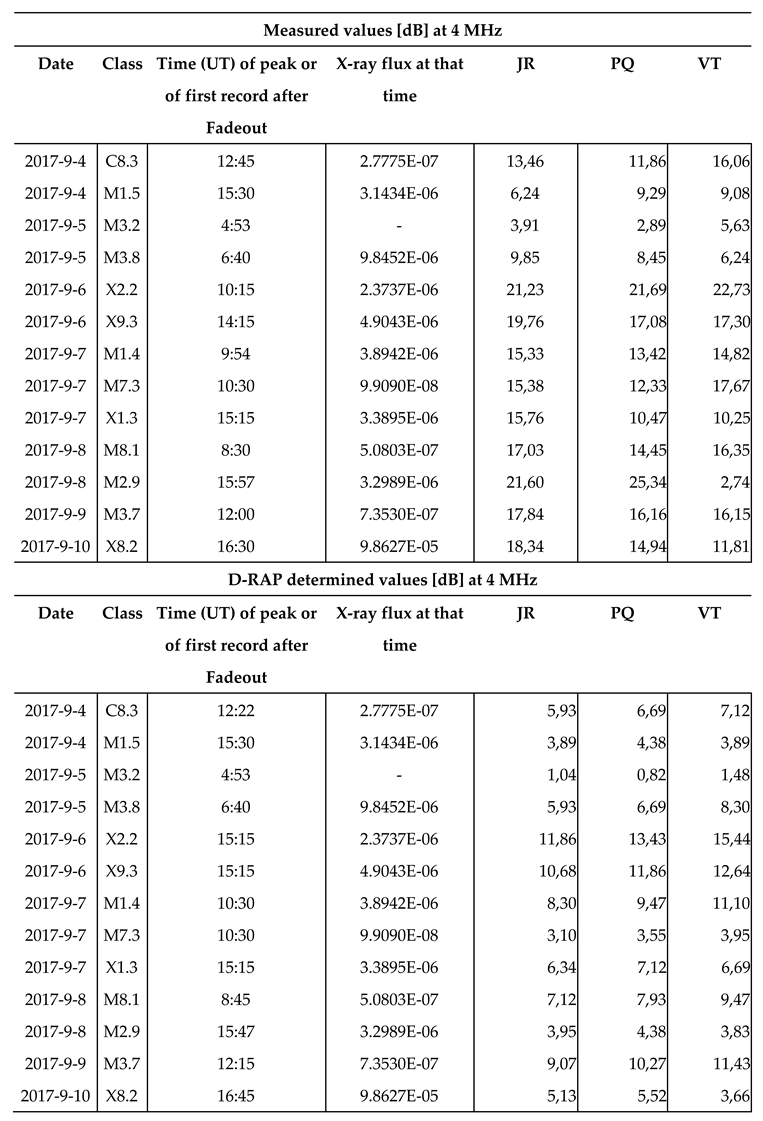 |
| Measured values by the riometers (30-32 MHz) | ||||||||
| Date | Class | Peak Time (UT) | ABI | IVA | SOD | ROV | OUL | JYV |
| 2017-9-4 | C8.3 | 12:22 | 0.14 | 0.13 | - | 0.24 | 0.14 | 0.1 |
| 2017-9-4 | M1.5 | 15:30 | 0.59 | 0.11 | - | 0.57 | 0.1 | 0.08 |
| 2017-9-5 | M3.2 | 4:53 | 1.22 | 1.06 | - | 0.36 | 0.19 | 0.09 |
| 2017-9-5 | M3.8 | 6:40 | 1.0 | 0.64 | - | 0.36 | 0.23 | 0.17 |
| 2017-9-6 | X2.2 | 9:10 | 1.53 | 1.12 | - | 1.36 | 1.47 | 1.45 |
| 2017-9-6 | X9.3 | 12:02 | 2.62 | 1.79 | - | 1.56 | 2.01 | 1.58 |
| 2017-9-6 | Proton | 13:05 | 1.16 | 0.97 | - | 0.45 | 0.33 | 0.26 |
| 2017-9-7 | M1.4 | 9:54 | ||||||
| 2017-9-7 | M7.3 | 10:15 | ||||||
| 2017-9-7 | X1.3 | 14:36 | 2.11 | 1.46 | 1.86 | 1.210 | 0.65 | 0.48 |
| 2017-9-8 | M8.1 | 7:49 | 1.3 | 1.04 | 1.8 | 1.18 | 0.85 | 0.38 |
| 2017-9-8 | M2.9 | 15:47 | 4.13 | 3.08 | 3.79 | 1.81 | 1.18 | - |
| 2017-9-9 | M3.7 | 11:04 | 0.65 | 0.46 | 0.78 | 0.5 | 0.7 | 0.54 |
| 2017-9-10 | X8.2 | 16:06 | 1.06 | 0.37 | 1.04 | 0.72 | 0.57 | 0.6 |
| 2017-9-10 | Proton | 17:20-17:30 | 2.29 | 1.1 | 1.48 | 0.71 | 0.2 | 0.22 |
| Values determined by D-RAP (30-32 MHz) | ||||||||
| Date | Class | Peak Time (UT) | ABI | IVA | SOD | ROV | OUL | JYV |
| 2017-9-4 | C8.3 | 12:22 | 0.249 | 0.249 | 0.249 | 0.225 | 0.268 | 0.257 |
| 2017-9-4 | M1.5 | 15:30 | 0.159 | 0.122 | 0.127 | 0.113 | 0.13 | 0.118 |
| 2017-9-5 | M3.2 | 4:53 | 2.598 | 2.074 | 0.336 | 0.299 | 0.219 | 0.146 |
| 2017-9-5 | M3.8 | 6:40 | 2.963 | 2.308 | 0.46 | 0.41 | 0.426 | 0.324 |
| 2017-9-6 | X2.2 | 9:10 | - | - | - | - | - | - |
| 2017-9-6 | X9.3 | 12:02 | 2.368 | 1.998 | 1.138 | 1.014 | 1.122 | 1.014 |
| 2017-9-6 | Proton | 13:05 | 2.177 | 1.923 | 1.04 | 0.927 | 0.849 | 0.669 |
| 2017-9-7 | M1.4 | 9:54 | ||||||
| 2017-9-7 | M7.3 | 10:15 | ||||||
| 2017-9-7 | X1.3 | 14:36 | 3.602 | 2.963 | 0.636 | 0.567 | 0.4 | 0.343 |
| 2017-9-8 | M8.1 | 7:49 | 5.387 | 5.422 | 1.597 | 1.423 | 0.675 | 0.533 |
| 2017-9-8 | M2.9 | 15:47 | 2.145 | 2.138 | 2.138 | 1.905 | 2.138 | 1.911 |
| 2017-9-9 | M3.7 | 11:04 | 0.675 | 0.636 | 0.565 | 0.503 | 0.52 | 0.495 |
| 2017-9-10 | X8.2 | 16:06 | 0.268 | 0.164 | 0.167 | 0.148 | 0.169 | 0.153 |
| 2017-9-10 | Proton | 17:20-17:30 | 2.32 | 1.656 | 0.636 | 0.567 | 0 | 0 |
Disclaimer/Publisher’s Note: The statements, opinions and data contained in all publications are solely those of the individual author(s) and contributor(s) and not of MDPI and/or the editor(s). MDPI and/or the editor(s) disclaim responsibility for any injury to people or property resulting from any ideas, methods, instructions or products referred to in the content. |
© 2024 by the authors. Licensee MDPI, Basel, Switzerland. This article is an open access article distributed under the terms and conditions of the Creative Commons Attribution (CC BY) license (http://creativecommons.org/licenses/by/4.0/).





